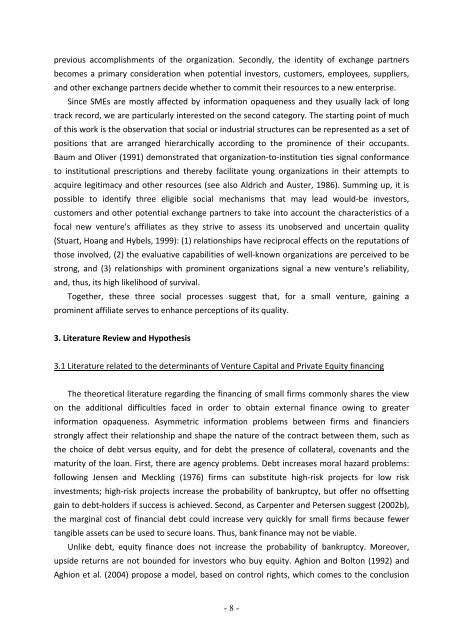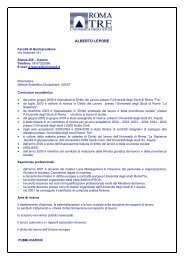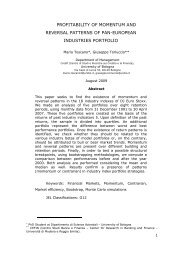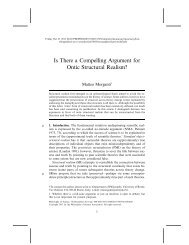Determinants and effects of Venture Capital and Private Equity ...
Determinants and effects of Venture Capital and Private Equity ...
Determinants and effects of Venture Capital and Private Equity ...
You also want an ePaper? Increase the reach of your titles
YUMPU automatically turns print PDFs into web optimized ePapers that Google loves.
previous accomplishments <strong>of</strong> the organization. Secondly, the identity <strong>of</strong> exchange partners<br />
becomes a primary consideration when potential investors, customers, employees, suppliers,<br />
<strong>and</strong> other exchange partners decide whether to commit their resources to a new enterprise.<br />
Since SMEs are mostly affected by information opaqueness <strong>and</strong> they usually lack <strong>of</strong> long<br />
track record, we are particularly interested on the second category. The starting point <strong>of</strong> much<br />
<strong>of</strong> this work is the observation that social or industrial structures can be represented as a set <strong>of</strong><br />
positions that are arranged hierarchically according to the prominence <strong>of</strong> their occupants.<br />
Baum <strong>and</strong> Oliver (1991) demonstrated that organization‐to‐institution ties signal conformance<br />
to institutional prescriptions <strong>and</strong> thereby facilitate young organizations in their attempts to<br />
acquire legitimacy <strong>and</strong> other resources (see also Aldrich <strong>and</strong> Auster, 1986). Summing up, it is<br />
possible to identify three eligible social mechanisms that may lead would‐be investors,<br />
customers <strong>and</strong> other potential exchange partners to take into account the characteristics <strong>of</strong> a<br />
focal new venture's affiliates as they strive to assess its unobserved <strong>and</strong> uncertain quality<br />
(Stuart, Hoang <strong>and</strong> Hybels, 1999): (1) relationships have reciprocal <strong>effects</strong> on the reputations <strong>of</strong><br />
those involved, (2) the evaluative capabilities <strong>of</strong> well‐known organizations are perceived to be<br />
strong, <strong>and</strong> (3) relationships with prominent organizations signal a new venture's reliability,<br />
<strong>and</strong>, thus, its high likelihood <strong>of</strong> survival.<br />
Together, these three social processes suggest that, for a small venture, gaining a<br />
prominent affiliate serves to enhance perceptions <strong>of</strong> its quality.<br />
3. Literature Review <strong>and</strong> Hypothesis<br />
3.1 Literature related to the determinants <strong>of</strong> <strong>Venture</strong> <strong>Capital</strong> <strong>and</strong> <strong>Private</strong> <strong>Equity</strong> financing<br />
The theoretical literature regarding the financing <strong>of</strong> small firms commonly shares the view<br />
on the additional difficulties faced in order to obtain external finance owing to greater<br />
information opaqueness. Asymmetric information problems between firms <strong>and</strong> financiers<br />
strongly affect their relationship <strong>and</strong> shape the nature <strong>of</strong> the contract between them, such as<br />
the choice <strong>of</strong> debt versus equity, <strong>and</strong> for debt the presence <strong>of</strong> collateral, covenants <strong>and</strong> the<br />
maturity <strong>of</strong> the loan. First, there are agency problems. Debt increases moral hazard problems:<br />
following Jensen <strong>and</strong> Meckling (1976) firms can substitute high‐risk projects for low risk<br />
investments; high‐risk projects increase the probability <strong>of</strong> bankruptcy, but <strong>of</strong>fer no <strong>of</strong>fsetting<br />
gain to debt‐holders if success is achieved. Second, as Carpenter <strong>and</strong> Petersen suggest (2002b),<br />
the marginal cost <strong>of</strong> financial debt could increase very quickly for small firms because fewer<br />
tangible assets can be used to secure loans. Thus, bank finance may not be viable.<br />
Unlike debt, equity finance does not increase the probability <strong>of</strong> bankruptcy. Moreover,<br />
upside returns are not bounded for investors who buy equity. Aghion <strong>and</strong> Bolton (1992) <strong>and</strong><br />
Aghion et al. (2004) propose a model, based on control rights, which comes to the conclusion<br />
- 8 -

















